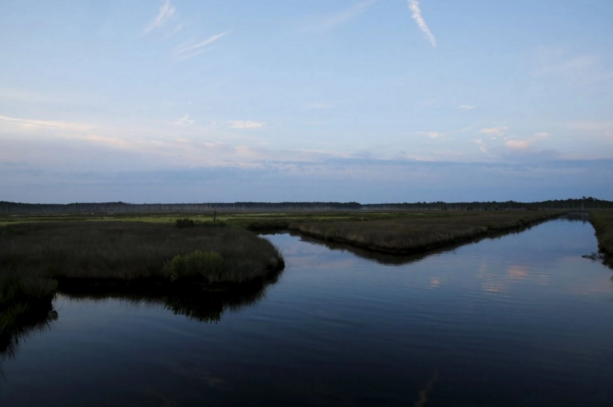Supreme Court Ends Challenge To The Chesapeake Bay Cleanup Plan
A piece of good news and a substantial step forward in the fight for water quality in the Chesapeake Bay. Once highly polluted, the two most prolific spawning grounds for striped bass, the Hudson River and Chesapeake Bay, seem to be on the road to recovery.

The sky is reflected on Parsons Creek after sunrise in Madison, Md., in August. The Chesapeake Bay estuary is the largest in the United States, at a surface area of 4,480 square miles. (Jonathan Ernst/Reuters)
By Darryl Fears March 1
The Supreme Court has declined to hear a challenge to the Chesapeake Bay cleanup plan, the largest attempt by the federal government and states to rid the pollution from a body of water and to restore its health.
The high court’s refusal ends an attempt by the American Farm Bureau Federation to stop the cleanup. The organization argued that the Environmental Protection Agency overstepped its authority in leading the effort because the bay can be managed only by the states that sit in its watershed.
[Federal judge upholds Chesapeake Bay cleanup plan]
The lower court ruling now stands. In that 2013 decision, U.S. District Court Judge Sylvia H. Rambo wrote that the EPA is within its rights under the Clean Water Act to partner with the six states in the bay watershed to cut the pollution that pours in from sewers, construction developments and chemical and biological waste from farms.
“The ecological and economic importance of the Chesapeake Bay is well documented,” she wrote, concluding that “the court endorses the holistic, watershed approach used here. This approach receives ample support in the [Clean Water Act], its legislative history, and Supreme Court precedent.”
The question is whether the EPA could now move to clean other massive, multistate water bodies. Impaired waters have led to fish-killing dead zones and other marine life die-offs for decades.
Critics of the American Farm Bureau Federation’s challenge said the group had shown little interest in the bay before the suit was filed in 2011, and they called it a strategic effort to preempt the federal government from regulating pollution that runs off mega-farms it represents into the Mississippi River.
They pointed to a speech by the farm bureau’s president, Bob Stallman, to support that claim. “This new EPA approach will not end with the Chesapeake Bay,” Stallman said at the group’s 2011 convention. “EPA has already revealed its plan to follow suit in other watersheds across the nation, including the Mississippi watershed.”
Attorneys general in 21 states joined Stallman when the farm bureau appealed Rambo’s decision. The prosecutors, most of them Republicans from as far as Alaska and Montana, filed an amicus brief in support of stopping the EPA’s plan.
“If this [cleanup] is left to stand,” they argued in their brief to the U.S. Court of Appeals for the 3rd Circuit, “other watersheds, including the Mississippi River Basin, could be next.” The appeals judges did not block the plan.
One of the farm bureau’s critics, Chesapeake Bay Foundation President William Baker, described Monday’s outcome as historic. “Everyone who cares about clean water can breathe easier now that the Supreme Court has let stand the lower court decision that Chesapeake Clean Water Blueprint is perfectly legal under the federal Clean Water Act.”
[Opposition threatens Chesapeake Bay cleanup plan]
Baker renewed his call to the farm bureau and others that joined its challenge, such as home builders and chemical companies, to put aside their differences and work to clean the nation’s largest estuary. But his final comment could serve to stoke them. “Our collective … efforts … can be a model for other waters worldwide.”
Farmers worry that regulations such as those in the bay plan could cut their profit margins or run them into debt. The cleanup placed the bay on a pollution diet that called on farmers to spend tens of thousands of dollars to install barriers to fertilizers, soil and manure that poured off farms with storm water into streams, creeks and rivers that lead to the bay.
Municipalities also complained about requirements that called on them to limit sewer overflows during heavy rain that sent human waste awash in storm water into tributaries to the Chesapeake. Those fixes will cost tens of millions of dollars to cities such as the District and counties such as Anne Arundel.
Full Article Source: https://www.washingtonpost.com/news/energy-environment/wp/2016/03/01/supreme-court-ends-challenge-to-the-chesapeake-bay-cleanup-plan/







